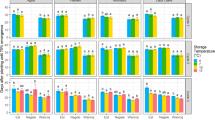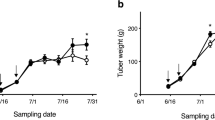Abstract
Potato tuber number, size and quality determine crop value. Elevated soil temperature often reduces yield and quality. Effects of cool soil are less well understood. Potatoes were grown in a greenhouse with 22 °C days and 18 °C nights. Shortly after emergence, soil temperature in some pots was lowered to 10–14 °C using cooling coils wrapped around individual pots. Soil temperature of ambient temperature controls was 17–21 °C. Tuber number and total tuber weight were determined for two chip and four fresh market varieties grown in chilled and ambient temperature soil. Tuber number with chilled soil averaged 3.2 times that of controls. Tuber weight was comparable between the two treatments. ‘Red Norland’ skin was lighter red and ‘Adirondack Blue’ skin was darker purple with chilled soil compared with controls. Skin color was unchanged for the other varieties. Overall, the data suggest that cool soil influences commercially important characteristics of potato.
Resumen
El número, el tamaño y la calidad del tubérculo de papa determinan el valor del cultivo. La temperatura elevada del suelo a menudo reduce el rendimiento y la calidad. Los efectos del suelo frío son menos entendidos. Las papas se cultivaban en un invernadero con 22 °C de día y 18 °C de noche. Poco después de la emergencia, la temperatura del suelo en algunas macetas se redujo a 10–14 °C utilizando bobinas de enfriamiento envueltas alrededor de macetas individuales. La temperatura del suelo de los testigos de temperatura ambiente fue de 17–21 °C. El número de tubérculos y el peso total del tubérculo se determinaron para dos variedades de fritura y cuatro de mercado fresco cultivadas en suelos refrigerados y a temperatura ambiente. El número de tubérculos con suelo refrigerado promedió 3,2 veces el de los testigos. El peso del tubérculo fue comparable entre los dos tratamientos. La piel de ‘Red Norland’ era de color rojo más claro y la piel de ‘Adirondack Blue’ era de color púrpura más oscuro con suelo frío en comparación con los testigos. El color de la piel no cambió para las otras variedades. En general, los datos sugieren que el suelo frío influye en las características comercialmente importantes de la papa.






Similar content being viewed by others
References
Burt, R.L. 1964. Influence of short periods of low temperature on tuber initiation in the potato. European Potato Journal 7: 197–208. https://doi.org/10.1007/BF02368251.
Epstein, E. 1966. Effect of soil temperature at different growth stages on growth and development of potato plants. Agronomy Journal 58: 169–171. https://doi.org/10.2134/agronj1966.00021962005800020014x.
Epstein, E. 1971. Effect of soil temperature on mineral element composition and morphology of the potato plant. Agronomy Journal 63: 664–666. https://doi.org/10.2134/agronj1971.00021962006300050002x.
Ewing, E.E., and P.C. Struik. 1992. Tuber formation in potato: Induction, initiation, and growth. Horticultural Reviews 14: 89–198.
Gao-Takai, M., A. Katayama-Ikegami, K. Matsuda, H. Shindo, S. Uemae, and M. Oyaizu. 2019. A low temperature promotes anthocyanin biosynthesis but does not accelerate endogenous abscisic acid accumulation in red-skinned grapes. Plant Science 283: 165–176. https://doi.org/10.1016/j.plantsci.2019.01.015.
He, Q., Y. Ren, W. Zhao, R. Li, and L. Zhang. 2020. Low temperature promotes anthocyanin biosynthesis and related gene expression in the seedlings of purple head Chinese cabbage (Brassica rapa L.). Genes 11: 81. https://doi.org/10.3390/genes11010081.
Hoagland, D.R. and D.I. Arnon . 1950. The water-culture method for growing plants without soil. California Agricultural Experiment Station Circular, University of California College of Agriculture, Berkeley, CA, Vol. 347.
Liu, Y., Y. Tikunov, R.E. Schouten, L.F.M. Marcelis, R.G.F. Visser, and A. Bovy. 2018. Anthocyanin biosynthesis and degradation mechanisms in Solanaceous vegetables: A review. Frontiers in Chemistry 6: 52. https://doi.org/10.3389/fchem.2018.00052.
Lo Piero, A.R., I. Puglisi, P. Rapisarda, and G. Petrone. 2005. Anthocyanins accumulation and related gene expression in red orange fruit induced by low temperature storage. Journal of Agricultural and Food Chemistry. 53: 9083–9088. https://doi.org/10.1021/jf051609s.
Lorenz, O.A. 1950. Air and soil temperatures in potato fields, Kern County, California, during spring and early summer. American Potato Journal 27: 396–407. https://doi.org/10.1007/BF02850273.
Mao, W., Y. Han, Y. Chen, M. Sun, Q. Feng, L. Li, L. Liu, K. Zhang, L. Wei, Z. Han, and B. Li. 2022. Low temperature inhibits anthocyanin accumulation in strawberry fruit by activating FvMAPK3-induced phosphorylation of FvMYB10 and degradation of Chalcone Synthase 1. The Plant Cell 34: 1226–1249. https://doi.org/10.1093/plcell/koac006.
Midmore, D.J. 1984. Potato (Solanum spp.) in the hot tropics I. Soil temperature effects on emergence, plant development and yield. Field Crops Research 8: 255–271. https://doi.org/10.1016/0378-4290(84)90073-X.
O’Brien, P.J., E.J. Allen, and D.M. Firman. 1998. A review of some studies into tuber initiation in potato (Solanum tuberosum) crops. The Journal of Agricultural Science 130: 251–270. https://doi.org/10.1017/S0021859698005280.
Park, J.-S.S.-J., S.-Y. Park, A.-Y. Kwon, K.-B. Shin, J.M. Moon, H.S. Park, S.U. Cho, J.-H. Park, H.-S. Kim Jeon, and H.-J. Lee. 2022. Temporally distinct regulatory pathways coordinate thermo-responsive storage organ formation in potato. Cell Reports 38: 110579. https://doi.org/10.1016/j.celrep.2022.110579.
Reynolds, M.P., and E.E. Ewing. 1989. Effects of high air and soil temperature stress on growth and tuberization in Solanum tuberosum. Annals of Botany 64: 241–247. https://doi.org/10.1093/oxfordjournals.aob.a087837.
Sale, P.J.M. 1979. Growth of potatoes (Solanum tuberosum L.) to the small tuber stage as related to soil temperature. Australian Journal of Agricultural Research 30: 667–675. https://doi.org/10.1071/AR9790667.
Stiles, E.A., B.N.B. Cecha, S.M. Deea, and E.P. Lacey. 2007. Temperature-sensitive anthocyanin production in flowers of Plantago lanceolata. Physiologia Plantarum 129: 756–765.
Struik, P.C., J. Geertsema, and C.H.M.G. Custers. 1989. Effects of shoot, root and stolon temperature on the development of the potato (Solanum tuberosum L.) plant. III. Development of tubers. Potato Research 32: 151–158. https://doi.org/10.1007/BF02358227.
Van Denburgh, R.W., L.K. Hiller, and D.C. Koller. 1980. The effect of soil temperatures on brown center development in potatoes. American Potato Journal 57: 371–375. https://doi.org/10.1007/BF02854328.
Wang, N., C. Qu, S. Jiang, Z. Chen, H. Xu, H. Fang, M. Su, J. Zhang, Y. Wang, W. Liu, Z. Zhang, N. Lu, and X. Chen. 2018. The proanthocyanidin-specific transcription factor MdMYBPA1 initiates anthocyanin synthesis under low-temperature conditions in red-fleshed apples. Plant Journal 96: 39–55. https://doi.org/10.1111/tpj.14013.
Went, F.W. 1959. Effects of environment of parent and grandparent generations on tuber production by potatoes. American Journal of Botany 46: 277–282. https://doi.org/10.2307/2439479.
Yamaguchi, M., H. Timm, and A.R. Spurr. 1964. Effects of soil temperature on growth and nutrition of potato plants and tuberization, composition, and periderm structure of tubers. Proceedings of the American Society of Horticultural Science 84: 412–423.
Zommick, D.H., L.O. Knowles, M.J. Pavek, and N.R. Knowles. 2014. In-season heat stress compromises postharvest quality and low-temperature sweetening resistance in potato (Solanum tuberosum L.). Planta 239: 1243–1263. https://doi.org/10.1007/s00425-014-2048-8.
Acknowledgements
Partial funding for this project came from the Wisconsin Potato and Vegetable Growers Association Chip Committee. Special thanks are given to Thomas Whitten, who designed and fabricated the temperature measurement system, Bjorn Karlsson, who fabricated the cooling system, Sarah deVeer, who helped with plant care, and other staff at the University of Wisconsin Biotron who supported this project.
Author information
Authors and Affiliations
Corresponding author
Ethics declarations
Competing Interests
The author claims no competing interests.
Rights and permissions
Springer Nature or its licensor (e.g. a society or other partner) holds exclusive rights to this article under a publishing agreement with the author(s) or other rightsholder(s); author self-archiving of the accepted manuscript version of this article is solely governed by the terms of such publishing agreement and applicable law.
About this article
Cite this article
Bethke, P.C. Cool Soil Increases Potato (Solanum tuberosum) Tuber Number in Multiple Varieties and Alters Skin Color Intensity of ‘Red Norland’ and ‘Adirondack Blue’. Am. J. Potato Res. 100, 79–86 (2023). https://doi.org/10.1007/s12230-022-09901-3
Accepted:
Published:
Issue Date:
DOI: https://doi.org/10.1007/s12230-022-09901-3




